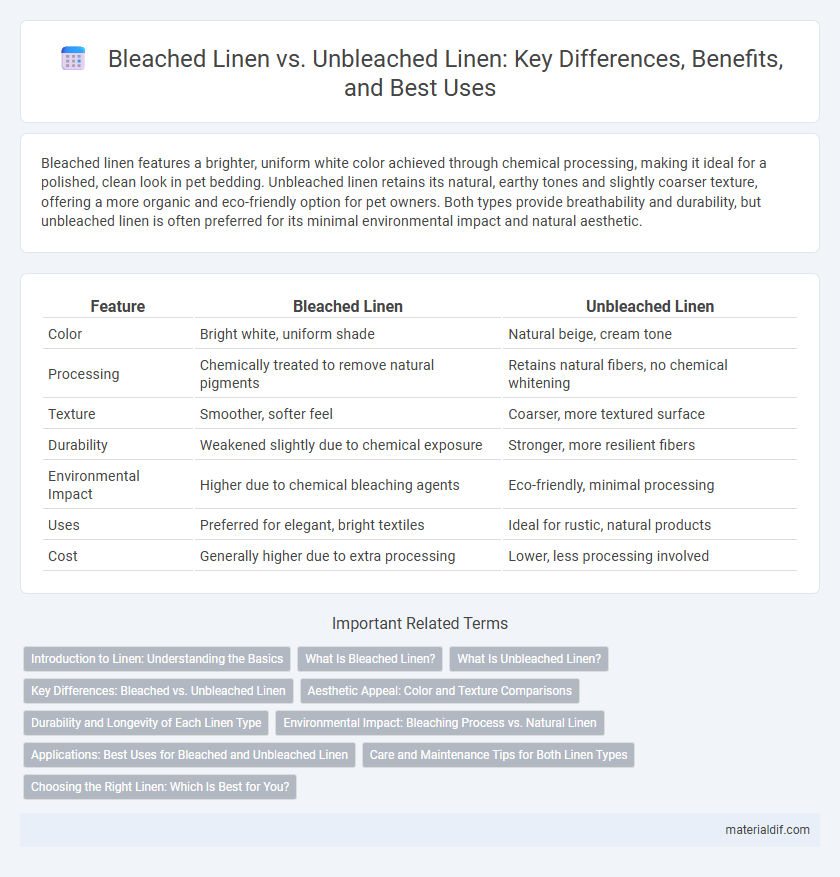Bleached linen features a brighter, uniform white color achieved through chemical processing, making it ideal for a polished, clean look in pet bedding. Unbleached linen retains its natural, earthy tones and slightly coarser texture, offering a more organic and eco-friendly option for pet owners. Both types provide breathability and durability, but unbleached linen is often preferred for its minimal environmental impact and natural aesthetic.
Table of Comparison
| Feature | Bleached Linen | Unbleached Linen |
|---|---|---|
| Color | Bright white, uniform shade | Natural beige, cream tone |
| Processing | Chemically treated to remove natural pigments | Retains natural fibers, no chemical whitening |
| Texture | Smoother, softer feel | Coarser, more textured surface |
| Durability | Weakened slightly due to chemical exposure | Stronger, more resilient fibers |
| Environmental Impact | Higher due to chemical bleaching agents | Eco-friendly, minimal processing |
| Uses | Preferred for elegant, bright textiles | Ideal for rustic, natural products |
| Cost | Generally higher due to extra processing | Lower, less processing involved |
Introduction to Linen: Understanding the Basics
Bleached linen undergoes a chemical process to remove its natural color, resulting in a brighter and more uniform appearance ideal for creating crisp, white textiles. Unbleached linen retains its natural beige or off-white hue, preserving the inherent texture and eco-friendly qualities that appeal to those seeking organic and less processed fabrics. Understanding these differences helps consumers choose linen products based on aesthetic preference, environmental impact, and intended use.
What Is Bleached Linen?
Bleached linen undergoes a chemical treatment process that removes natural pigments, resulting in a bright white and uniform fabric ideal for a crisp, clean appearance. This process enhances the fabric's softness and lightness while maintaining linen's inherent breathability and durability. Bleached linen is commonly used in formal bedding, tablecloths, and apparel where a pure, refined look is desired.
What Is Unbleached Linen?
Unbleached linen refers to flax fibers that retain their natural color and texture, avoiding chemical bleaching processes that strip away impurities and whiten the fabric. This type of linen preserves its organic, off-white to tan hue, maintaining more of the fiber's natural strength and durability. Choosing unbleached linen supports eco-friendly practices and results in textiles with a more rustic, authentic appearance.
Key Differences: Bleached vs. Unbleached Linen
Bleached linen undergoes a chemical whitening process that removes natural color and impurities, resulting in a bright, uniform white fabric with enhanced softness and durability. Unbleached linen retains its natural beige or grayish tone, preserving its organic texture and fibers, which may exhibit slight irregularities and a more rustic appearance. The choice between bleached and unbleached linen impacts fabric aesthetics, environmental considerations, and suitability for various textile applications.
Aesthetic Appeal: Color and Texture Comparisons
Bleached linen presents a crisp, bright white appearance that enhances a clean and refined aesthetic, often preferred for modern or minimalist designs. Unbleached linen retains its natural beige or off-white hue, showcasing a rustic and organic texture that adds warmth and character to textiles or home decor. The choice between bleached and unbleached linen significantly impacts visual softness, with bleached linen appearing smoother and unbleached linen exhibiting a more textured, tactile surface.
Durability and Longevity of Each Linen Type
Bleached linen undergoes chemical treatment that slightly weakens the fiber structure, potentially reducing its durability and shortening its lifespan compared to unbleached linen. Unbleached linen retains its natural fibers intact, offering superior strength and enhanced longevity, making it more resistant to wear and tear over time. Choosing unbleached linen generally ensures a more durable fabric that maintains its quality through frequent use and washing cycles.
Environmental Impact: Bleaching Process vs. Natural Linen
Bleached linen undergoes a chemical-intensive process that often involves chlorine or peroxide, contributing to water pollution and increased carbon emissions. Unbleached linen retains its natural fibers without harmful additives, significantly reducing environmental impact through lower energy use and fewer toxic byproducts. Choosing unbleached linen supports sustainable textiles by minimizing chemical waste and promoting eco-friendly production.
Applications: Best Uses for Bleached and Unbleached Linen
Bleached linen is ideal for applications requiring a clean, bright appearance such as tablecloths, bedding, and fashion garments where a crisp, white look is desired. Unbleached linen suits eco-friendly products, rustic home decor, and craft projects where natural texture and durability are prioritized. Both types excel in upholstery and towels, but choice depends on aesthetic preference and environmental considerations.
Care and Maintenance Tips for Both Linen Types
Bleached linen requires gentle washing in cold water to preserve its brightness and avoid fabric damage, while unbleached linen can often withstand slightly warmer temperatures due to its natural fibers. Both types benefit from air drying to minimize shrinkage and maintain texture, with ironing recommended on a medium setting to smooth wrinkles without compromising fiber integrity. Avoiding harsh detergents and bleach ensures longevity and keeps the linen soft and durable over time.
Choosing the Right Linen: Which Is Best for You?
Bleached linen offers a crisp, bright appearance ideal for formal home textiles and elegant apparel, while unbleached linen retains its natural, earthy tone, providing durability and eco-friendly appeal suited for rustic or casual items. Your choice depends on desired aesthetics and environmental considerations, with bleached linen preferred for vibrant, uniform color and unbleached linen favored for organic, chemical-free fabric. Understanding the differences in texture, care requirements, and environmental impact ensures selecting the best linen for your specific needs and preferences.
Bleached Linen vs Unbleached Linen Infographic

 materialdif.com
materialdif.com